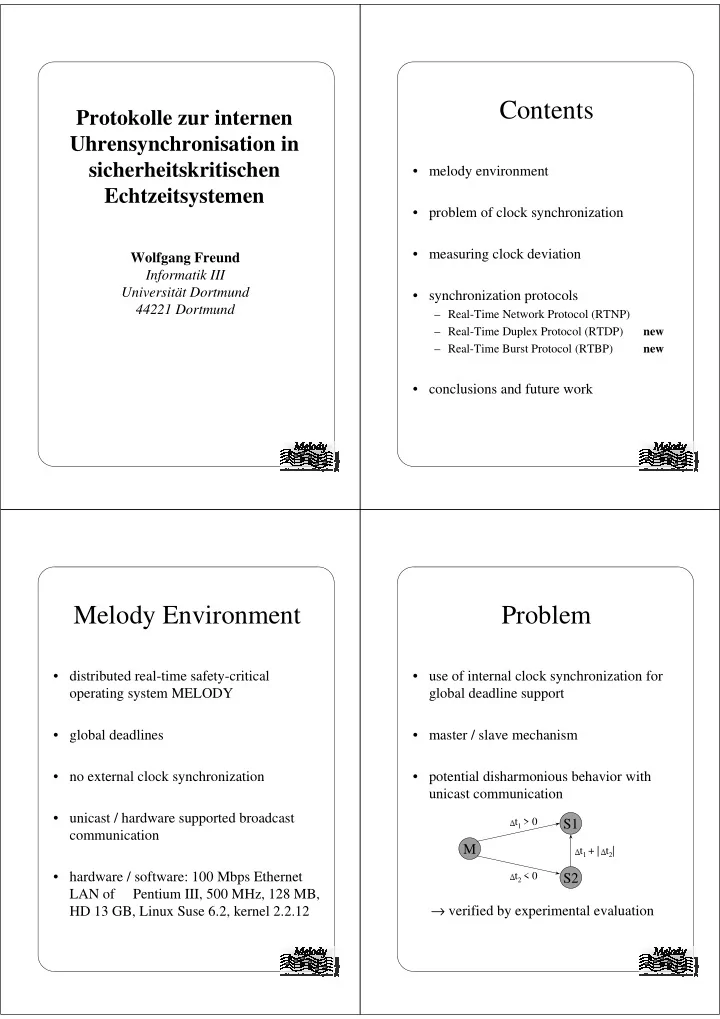

Contents Protokolle zur internen Uhrensynchronisation in sicherheitskritischen • melody environment Echtzeitsystemen • problem of clock synchronization • measuring clock deviation Wolfgang Freund Informatik III Universität Dortmund • synchronization protocols 44221 Dortmund – Real-Time Network Protocol (RTNP) – Real-Time Duplex Protocol (RTDP) new – Real-Time Burst Protocol (RTBP) new • conclusions and future work Melody Environment Problem • distributed real-time safety-critical • use of internal clock synchronization for operating system MELODY global deadline support • global deadlines • master / slave mechanism • no external clock synchronization • potential disharmonious behavior with unicast communication • unicast / hardware supported broadcast t 1 > 0 S1 communication M t 1 + | t 2 | • hardware / software: 100 Mbps Ethernet S2 t 2 < 0 LAN of Pentium III, 500 MHz, 128 MB, → verified by experimental evaluation HD 13 GB, Linux Suse 6.2, kernel 2.2.12
Measuring Clock Real-Time Network Deviations Protocol (RTNP) • roundtrip message: • Broadcast message from the master invokes the slaves to start the synchronization master → slave → master procedure. • communication delays (10.000 measurements) • unicast roundtrip synchronization message 6000 5000 Master UC-Node-S3 Number of Arrivals 4000 UC-Node-S5 m 1 m 2 UC-Node-S6 3000 BC-Node-S3 BC-Node-S5 2000 Slave BC-Node-S6 t 2 t 3 t 4 Standard Arrival 1000 Window (SAW) Standard Communication Delay t 1 t 5 0 100 101 102 103 104 105 106 107 108 109 110 111 112 113 114 115 • m 2 includes master time stamp. Communication Delays [usec] Properties: • If m 2 fails to fit into this window, it will be 1. standard communication delay ignored, and another attempt has to be made. 2. standard / minimum com. delay differ at most 2 µsec • local update for clock drift correction 3. unicast / broadcast messages differs at most 2 µsec 4. symmetry 5. time stamp overhead at most 200 nsec Real-Time Duplex Real-Time Burst Protocol (RTDP) Protocol (RTBP) • start-master, synchronization-master • protocol timing cycle 1 cycle 2 cycle 3 • protocol timing Node M cycle 1 cycle 2 m m Node S a m m Node M a Node S b m 2 m 1 Node M b Time 1 1 2 2 3 3 3 t t t t t t t m 2 m 1 SAW 1 3 1 3 1 2 3 Node S Std. com. delay 1 2 t t Time 1 1 1 1 1 2 2 2 2 2 2 2 2 2 t t t t t t t t t t t t SAW 1 3 4 5 7 1 2 3 4 5 6 7 init std. com. delay 1 1 t t • sync. phase (MELODY): cycle 1 , cycle 2 , ..., 2 6 • sync. phase (MELODY): cycle 1 , ..., cycle 12 cycle 12 [360 µs] [1.5 ms] • m 2 includes master time stamp. • m includes master time stamp. • If m 2 fails to fit into one of the windows, it • If m fails to fit into one of the windows, it will will be ignored, and another cycle must be be ignored, and another cycle must be used. used. • local update for clock drift correction • local update for clock drift correction
Accuracy of Master- RTBP Evaluation Slave Synchronization M-S5 M-S6 S6-S5 1500 Trend(S6-S5) Trend(M-S5) Trend(M-S6) RTNP RTDP RTBP 1500 Trend(RTBP) Trend(RTDP) Trend(RTNP) 1000 1000 clock deviation [nsec] 500 500 clock deviation [nsec] 0 0 -500 -500 -1000 -1000 -1500 -1500 0 60 120 180 240 300 360 420 480 -2000 Time [sec] -2500 0 60 120 180 240 300 360 420 480 Time [sec] Conclusions and Future Work • more details: 12th Euromicro Conference on Real-Time Systems, Stockholm, Sweden, June 19 - 21, 2000 • disharmonious RTNP • novel broadcast protocols RTDP and RTBP → harmonious behavior → higher accuracy than unicast → higher fault tolerance capability • future work → installing the new protocols as MELODY functions → protocol overhead evaluation → fault tolerance studies
Recommend
More recommend